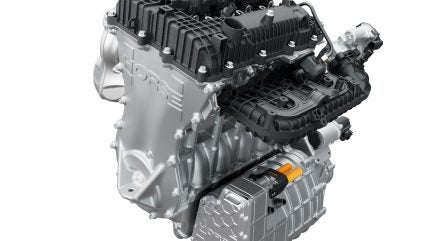
Horse Powertrain, a Renault-Geely JV that specialises in powertrains, has revealed its Future Hybrid System powertrain – enabling OEMs to hybridise Battery Electric Vehicle (BEV) platforms – at IAA 2025.
The company says Future Hybrid System is a revolutionary “all-in-one” hybrid powertrain that combines an engine, transmission, motor, and power electronics into a single system.

Discover B2B Marketing That Performs
Combine business intelligence and editorial excellence to reach engaged professionals across 36 leading media platforms.
A significant iteration from the “Future Hybrid Concept” first shown this year at Auto Shanghai, it replaces the front electric drive unit of a BEV, offering an ‘affordable and effective way’ to convert BEVs into hybrid EVs (HEVs), plug-in hybrid EVs (PHEVs), and range-extended EVs (REEVs).
Horse says Future Hybrid System is a flagship offering within Horse Powertrain’s X-Range family, a category of solutions designed to enrich EV platforms with combustion and hybrid technology.
At IAA, Horse Powertrain has revealed two variants:
- Performance: a 740mm-wide variant which employs two motors in a P1 + P3 configuration (one at the engine output shaft, and another at the transmission output shaft).
- Ultra-Compact: a 650mm-wide variant which uses a motor in a P2 configuration (between the engine and transmission).
Both variants use a 1.5-litre, four-cylinder engine and dedicated hybrid transmission. They also contain the full suite of power electronics required for hybrid powertrains and can also seamlessly integrate with systems like a DC/DC converter, on-board charger, and an 800V charging booster to maximize performance at low voltages.
Matias Giannini, Chief Executive Officer of Horse Powertrain, says: “Future Hybrid System is a perfect representation of what we are about as a company: freeing up the resources of automakers and OEMs that would otherwise be spent on reinventing powertrain categories. By providing a frictionless way to broaden their line-ups on existing architectures, we allow OEMs to continue to dedicate all their resources on accelerating EVs while offering a way to maximize the return on their investment in EV vehicle platforms, reducing complexity and focusing on their differentiators in today’s market – design, software, and full electrification.”
Horse Powertrain also says it is actively investigating additional Future Hybrid System variants that could increase the system’s compactness. These include three-cylinder variants that could reduce the unit’s width by a further 70mm.
Future Hybrid System
Fitted in an East/West orientation, Future Hybrid System features a ‘slimline’ top with a wider profile at the bottom, ensuring compliance with the latest crash test requirements. The unique integration of the sub-systems enables reduction of the front overhang by as much as 150mm, versus a conventional hybrid powertrain.
Like BEV-native electric drive units, the powertrain is mounted directly to the vehicle’s subframe. This, Horse says, maximizes re-use of BEV components and streamlines manufacturing, eliminating costly retooling and change processes.
It is also claimed the packaging advantages offered by Future Hybrid System make it particularly well-suited to converting BEVs into all-wheel drive (AWD) REEVs. Traditionally, AWD REEVs would require placing an engine and generator on top of the front electric drive unit, which make the powertrain too tall or long for the front compartment.
By contrast, Horse says, Future Hybrid System allows the easy conversion of a BEV platform into an AWD REEV in conjunction with a P4 motor (located near the rear axle), with no modifications required to the front compartment’s other components or its shape. Further, Future Hybrid System’s Performance variant can independently propel a vehicle on its own, providing a cost-effective front-wheel drive (FWD) hybrid solution.
Horse also says the compact solution allows a vehicle to retain subsystems that are packaged in the front of a BEV platform but typically would not fit in the front of a hybrid. These include HVAC and air conditioning systems, particularly PFAS-free systems that require more packaging space than previous-generation air conditioning systems. This stands to significantly reduce the environmental impact of hybrids.
Ingo Scholten, Chief Technology Officer at Horse Powertrain, says: “Compared to traditional solutions, Future Hybrid System achieves an unprecedented degree of compactness: it’s shorter and narrower than any equivalent system on the market. Critically, this allows Future Hybrid System to pack a full hybrid powertrain into spaces originally designed for electric drive units, mounted via the vehicle’s subframe. It also unlocks new opportunities for OEMs, such all-wheel drive range-extended EVs in compact vehicles, or the use of PFAS-free air conditioning systems.”
Future Hybrid System has been designed to be used and operated anywhere in the world. It features a pre-chamber ignition system that supports a range of fuels, including gasoline, E85 ethanol flex fuels, M100 methanol fuel, and synthetic fuels.
Future Hybrid System ‘will be coming in 2027’ according to Horse.




